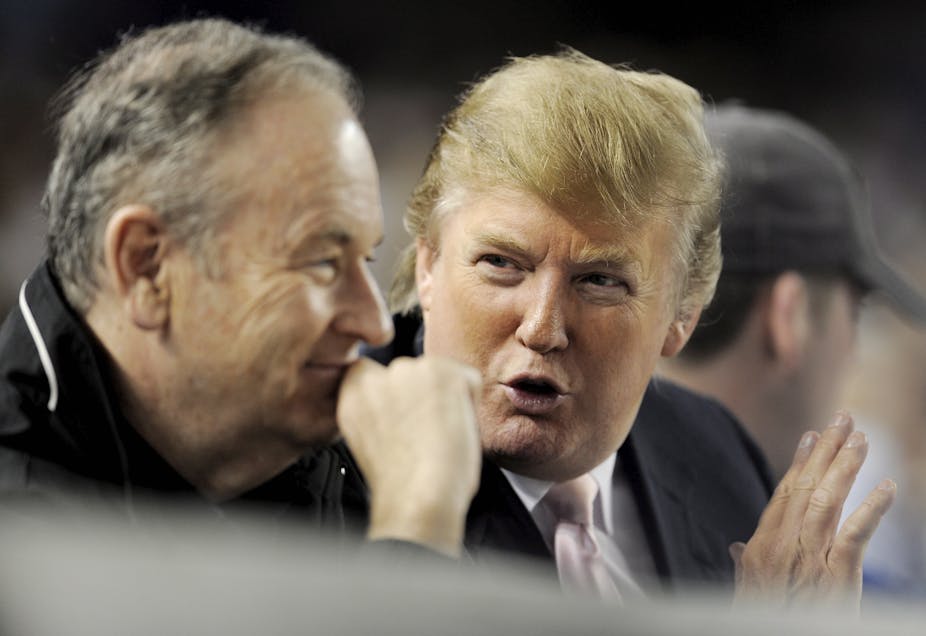When Fox News host Bill O'Reilly was finally fired after years of sexual harassment claims, it seemed like a welcome break from the norm: an exceptionally powerful man accused of sexual misconduct was for once not protected at all costs. While various harassment claims against Donald Trump failed to stop him in his path to the White House, O'Reilly, it seems, was not as invulnerable as he thought.
Yet while these two men faced very different outcomes, their cases have a lot in common. Crucially, the coverage of and public reaction to these incidents in fact reinforced some of the core elements of rape culture – a pervasive set of ideas and beliefs that normalise and even condone sexual misconduct in general, ultimately protecting perpetrators at the expense of victims.
But wait. Wasn’t O’Reilly brought down by a New York Times investigation? Wasn’t it the Washington Post who obtained the infamous tape of Trump caught bragging about sexually assaulting women with impunity? Yes It’s time to interrogate the role the media plays in protecting high-profile men accused of sexual misconduct, and in perpetuating the insidious myths they benefit from.
All branches of the media, particularly television news, rely heavily on sources to provide insight and commentary on any story – and from a producer or editor’s point of view, the more important the source, the better. The problem is that the most powerful sources are the best placed to shape the coverage with their words, no matter how outlandish or absurd. The upshot is that the intense coverage of these cases gives the accused themselves far more attention than their accusers.
Trump, for instance, responded to the scandal over the Access Hollywood tape by calling an extraordinary press conference hours before his second debate with Hillary Clinton, at which he was flanked by women who’d levelled sexual misconduct allegations at Bill Clinton – a man not even running for office. He then brought these women with him to the debate and pointed them out in the audience.
Trump’s publicity stunt clearly wasn’t an effort to win justice for Bill Clinton’s accusers. It was designed first to smear Hillary Clinton with guilt by association, and to tell voters that whatever accusations were levelled against Trump were far from unique and therefore somehow tolerable, while still of course denying they were credible at all.
Of course, the accused’s reactions to the allegations directed at them need to be included in news coverage. But Trump’s own words were given dramatically more exposure than those of his accusers, whose own stories and points of view simply did not generate anything like the same coverage.
This is compounded by a well-intentioned tradition of attempting to report stories “objectively” by presenting the point of view of both sides – but because a powerful accuser is more or less guaranteed to be listened to, this sort of coverage can actually end up advancing myths about rape and sexual misconduct.
However incorrect these myths are, they are both enduring and shockingly widespread. The ones that most often surface in news coverage are that victims are to blame, that sexual misbehaviour just isn’t as important as other issues, and that women who come forward are relatively likely to have fabricated their stories – and they must therefore be treated sceptically.
Taking control
O’Reilly has publicly peddled the unsubstantiated statement that women falsely accuse powerful men of sexual assault in order to ruin their careers and for personal profit. If a list were made of all the famous, wealthy, powerful men in Western societies, the proportion who have been accused of sexual misconduct and then formally sanctioned for it would be conspicuously small.
When the accusations against him began to mount, the far less articulate Trump also sought to discredit the integrity of his accusers a different way: “Look at her, I don’t think so…” And once again, his words rather than his accusers’ dominated the ensuing coverage.

Victim-blaming is more and more widely recognised as wrong, but it’s still both very common and disturbingly powerful. In the aftermath of the Access Hollywood tape debacle, many Trump surrogates, including Scottie Nell Hughes, tried to dismiss the women coming forward on the pretext that it was suspicious that they didn’t immediately report what had happened to them. Sarah Palin invoked the same idea during the O’Reilly debacle.
These ideas not only shift the responsibility for dealing with sexual assault onto victims, but also ignore evidence the majority of women who experience workplace sexual misconduct never report it. These myths are all the more powerful when propagated by female sources such as Hughes and Palin: if the accusers were credible, the logic goes, surely other women wouldn’t dismiss them?
As was made clear in the home stretch of the US election, powerful men accused of sexual misconduct can even turn the media attention they get to their advantage. When asked about sexual assault and the Access Hollywood tape, Trump and his surrogates were able to plead with the media and public to refocus the campaign on “important” issues – and now he’s president, as far as the media is concerned, it’s almost as if the astonishing claims against him had never been made.
Coverage of the extremely serious claims against Trump quickly faded after the Access Hollywood story had played out, and Trump is now president. But the O'Reilly case is perhaps cause for encouragement. Women have been accusing him of misbehaviour for years with little or no effect on his career – but now it appears even as powerful a figure as him is no longer guaranteed effective impunity.
Whatever the reason for this change, it is to be welcomed. In the interests of the victims of sexual misconduct everywhere, hopefully the media will keep up the pressure.

